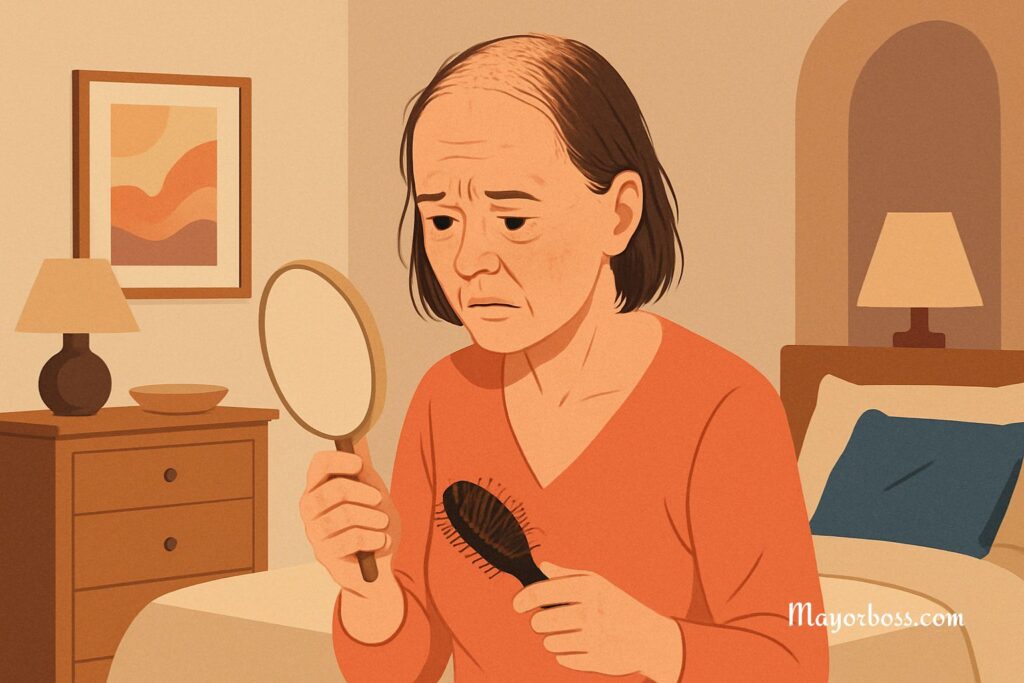7 Surprising Reasons Women Experience Hair Loss
Hair shedding is normal—losing about a handful each day allows fresh strands to replace the old ones. Yet when more hair than usual gathers on your brush or shower drain, concern naturally follows. Below are seven often‑overlooked triggers that can thin a woman’s ponytail, along with clear steps to help restore healthy growth.

1. Low Iron Stores Can Stall Hair Growth
Iron helps hair‑forming cells deliver oxygen to the scalp. When ferritin—the protein that holds extra iron—drops below about 60 ng/mL, follicles switch from growth to rest, so strands loosen earlier than they should. Even without full‑blown anemia, heavy periods, plant‑based eating patterns, or frequent blood donation can tip iron reserves too low. Researchers who compared women with diffuse shedding against controls found significantly lower ferritin in the hair‑loss group.
What to do: Ask your clinician for a ferritin blood test. If levels fall short, iron‑rich foods (lean beef, lentils, spinach) plus a doctor‑guided supplement often revive thicker growth within six months.
2. Hormonal Shifts From Birth Control Changes
Starting, stopping, or switching oral contraceptives can upset the estrogen‑to‑androgen balance that keeps follicles active. Pills with a higher androgen index let testosterone‑like hormones shrink follicles, triggering shedding known as telogen effluvium. A recent analysis even linked long‑term pill use to frontal fibrosing alopecia, a scarring form of loss along the hairline.
What to do: If thinning began a few months after a pill change, speak with your gynecologist about lower‑androgen options or non‑hormonal methods. Meanwhile, gentle styling and adequate protein support recovery.
3. Thyroid Affect Follicles
Thyroid hormones set the pace for nearly every cell, including those that build hair. When the gland underperforms, strands grow sluggishly, become dry, and break near the root. Women often notice thinning before classic symptoms such as fatigue or weight gain.
What to do: A simple blood panel measuring TSH and free T4 confirms the suspicion. If results show hypothyroidism, medication that normalizes hormone levels usually lets hair rebound within several months.
4. Chronic Stress
Persistent worry, grief, or high‑pressure workloads raise cortisol for weeks at a time. Elevated cortisol nudges many follicles into their resting phase all at once; three to four months later, excess strands fall out—a pattern called stress‑induced telogen effluvium.
What to do: Daily stress‑management habits—brisk walking, deep breathing, or journaling—lower cortisol and encourage regrowth. If stress feels unmanageable, seeking professional counseling protects both mind and hair.
5. Tight Hairstyles Cause Traction Alopecia
Sleek buns, high ponytails, or braids worn day after day pull constantly on the same roots. Over time, that tension injures the follicle’s anchoring structure, leading to gradual recession along the hairline and temples.
What to do: Rotate looser styles, shift part lines, and avoid elastic bands during sleep. Early traction alopecia often reverses once tension stops, but chronic traction can scar the follicle permanently, so prompt change matters.
6. Vitamin D Deficiency Silences Growth Signals
Vitamin D acts like a signaling molecule, instructing follicles when to start a new growth cycle. Low sunlight exposure, darker skin pigment, and sunscreen use can all lower serum vitamin D. Studies report a clear link between deficiency and several alopecia types.
What to do: A 25‑hydroxy vitamin D blood test shows the current status. Safe midday sun, fortified dairy or plant milks, fatty fish, and a physician‑recommended supplement help reactivate dormant follicles.
7. Recent Viral Illness, Including COVID‑19
Any high fever or severe infection pushes a surge of inflammatory cytokines through the body. Follicles interpret that signal as danger and pause growth. Three months later, synchronized shedding appears, sometimes in dramatic clumps. Many women see this after the flu or COVID‑19, even when their illness seemed mild.
What to do: The process usually resolves on its own within six to nine months. Balanced nutrition—including adequate protein, zinc, and omega‑3 fats—plus patience, gentle hair care, and stress control, fosters a healthy return.
Takeaway
Hair loss rarely stems from a single cause. Keeping a symptom diary—note diet changes, medication shifts, stress events, and hairstyle habits—gives your clinician clues. Laboratory checks for ferritin, thyroid hormones, vitamin D, and other nutrients build a clearer picture. When needed, a board‑certified dermatologist can offer targeted therapies such as topical minoxidil, low‑level laser devices, or, in autoimmune cases, prescription medications.
